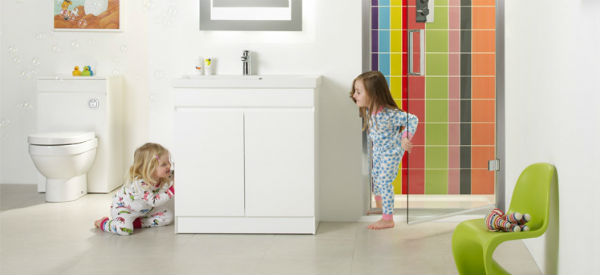
9 Tips For Making A Special Needs Friendly Bathroom
The bathroom can sometimes be particularly challenging for parents with children with special needs. Working to their needs is paramount whilst stimulating development, guidance and instruction allows them to build self-esteem and independence. However, due to the bathroom environment often being hazardous in nature; it is always wise to fully prepare your bathroom and to provide a safe layout. This can often mean purchasing or adjusting bathroom appliances and fixtures such as baths, rubber floor mats or balancing aids.
The Right Bathroom Design
The first step in considering a new bathroom design for your kids is to consider their limitations and whether the layout would benefit ease of access, storage space and whether accessories such as grab bars and hand rails would fit comfortably within the allocated bathroom space. Here are some tips on the variety of ways you can induce independence in the bathroom whilst ensuring that your child is happy with the environment.
1. Pull And Push Water Taps
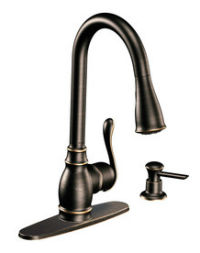 Many children may not have the strength to press or turn soap bottles, containers or water taps so it may therefore be useful to use products and fittings that are easy to operate (as mentioned in an earlier post). Pull and push water tap levers are beneficial instead of levers which turn tightly. By ensuring easy access you are providing an opportunity for independence and learning.
Many children may not have the strength to press or turn soap bottles, containers or water taps so it may therefore be useful to use products and fittings that are easy to operate (as mentioned in an earlier post). Pull and push water tap levers are beneficial instead of levers which turn tightly. By ensuring easy access you are providing an opportunity for independence and learning.
2. Keep Your Child Safe
The bathroom is where many families keep their medications. Keep your child safe, when putting in a new medicine cabinet make sure that you can lock it or keep it child-proof. It is also helpful if the cabinet is high enough so it will be out of your child's reach.
3. Grab Bars
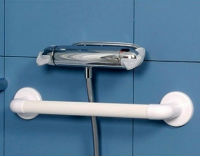 Grab bars can be installed at either side of the bath to provide support for standing and bending. Depending on your child’s mobility grab bars can also be installed near the toilet. Provide your child the opportunity to practice climbing in and out of a bathtub whilst offering support where it’s needed.
Grab bars can be installed at either side of the bath to provide support for standing and bending. Depending on your child’s mobility grab bars can also be installed near the toilet. Provide your child the opportunity to practice climbing in and out of a bathtub whilst offering support where it’s needed.
4. Non-Slip Mats
The bathroom can often be very slippery due to activities involving water so it essential that your child is stable and secure within your bath or shower area. Non-slip mats are an essential product for both parents and kids. Mats can provide stability as well as reducing excess water which can cause injury. A more expensive option is to apply anti- slip coating to the floor.
5. Walk-In Baths
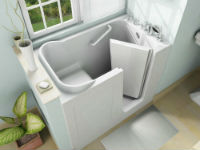 Walk-in baths are an ideal option that allows easier access for individuals with mobility issues. Walk-in baths come with a door and a seat that a child can sit on. It makes bathing much easier and can be a better option than a parent or carer lifting the child.
Walk-in baths are an ideal option that allows easier access for individuals with mobility issues. Walk-in baths come with a door and a seat that a child can sit on. It makes bathing much easier and can be a better option than a parent or carer lifting the child.
6. Lower Level Sink
If required, you can fit an extra water basin which can be lowered to your child’s height with easy reach tap levers.
7. Sensory Considerations
If your child has Autism then it is wise to make this room child friendly. Think about your child's sensory sensitivities and incorporate that into your bathroom. If your child has a favorite toy try and find similar bath toys that will stimulate their imagination and creativity.
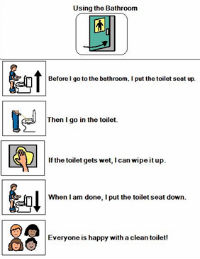 8. Hang A Visual Schedule Or Social Story
8. Hang A Visual Schedule Or Social Story
Creating a visual list or social story for using the toilet, washing hands, brushing teeth,and taking a shower or bath will be very helpful in providing independence in the bathroom. Make these lists part of the bathroom by hanging them up in easy to see areas of the bathroom.
9. Bathroom Colors
You may think about re-painting the walls bright colors to stimulate your child’s mind. Research has suggested that there is a correlation between color and human emotion. This will increase the child’s cognitive awareness and will allow the experience to be enjoyable which will then become a learnt process. Shades of blue and white create a fresh, awakening feeling however it is advised to avoid the color red as this is thought to emote aggression and anger. Although there is a vast amount of planning and preparation, these changes allow for your child to feel relaxed and safe within their environment whilst allowing them to learn and feel independent.


